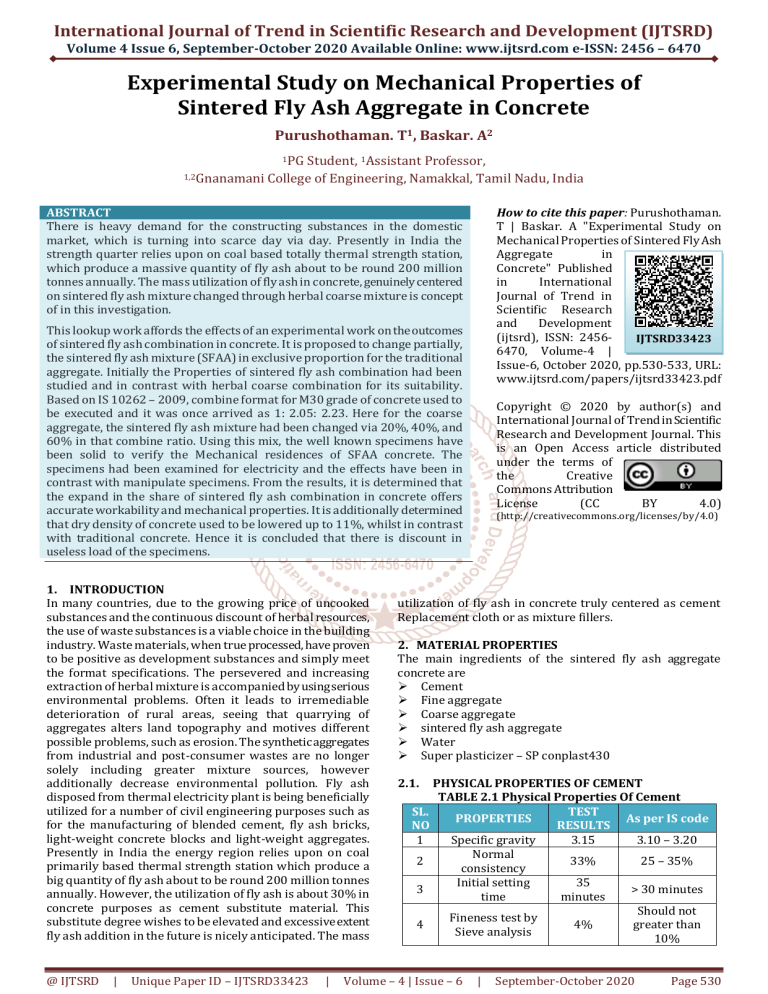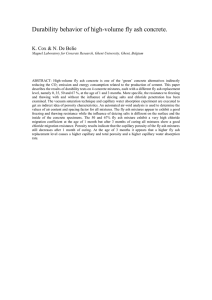
International Journal of Trend in Scientific Research and Development (IJTSRD)
Volume 4 Issue 6, September-October 2020 Available Online: www.ijtsrd.com e-ISSN: 2456 – 6470
Experimental Study on Mechanical Properties of
Sintered Fly Ash Aggregate in Concrete
Purushothaman. T1, Baskar. A2
1PG
Student, 1Assistant Professor,
1,2Gnanamani College of Engineering, Namakkal, Tamil Nadu, India
ABSTRACT
There is heavy demand for the constructing substances in the domestic
market, which is turning into scarce day via day. Presently in India the
strength quarter relies upon on coal based totally thermal strength station,
which produce a massive quantity of fly ash about to be round 200 million
tonnes annually. The mass utilization of fly ash in concrete, genuinely centered
on sintered fly ash mixture changed through herbal coarse mixture is concept
of in this investigation.
How to cite this paper: Purushothaman.
T | Baskar. A "Experimental Study on
Mechanical Properties of Sintered Fly Ash
Aggregate
in
Concrete" Published
in
International
Journal of Trend in
Scientific Research
and
Development
(ijtsrd), ISSN: 2456IJTSRD33423
6470, Volume-4 |
Issue-6, October 2020, pp.530-533, URL:
www.ijtsrd.com/papers/ijtsrd33423.pdf
This lookup work affords the effects of an experimental work on the outcomes
of sintered fly ash combination in concrete. It is proposed to change partially,
the sintered fly ash mixture (SFAA) in exclusive proportion for the traditional
aggregate. Initially the Properties of sintered fly ash combination had been
studied and in contrast with herbal coarse combination for its suitability.
Based on IS 10262 – 2009, combine format for M30 grade of concrete used to
be executed and it was once arrived as 1: 2.05: 2.23. Here for the coarse
aggregate, the sintered fly ash mixture had been changed via 20%, 40%, and
60% in that combine ratio. Using this mix, the well known specimens have
been solid to verify the Mechanical residences of SFAA concrete. The
specimens had been examined for electricity and the effects have been in
contrast with manipulate specimens. From the results, it is determined that
the expand in the share of sintered fly ash combination in concrete offers
accurate workability and mechanical properties. It is additionally determined
that dry density of concrete used to be lowered up to 11%, whilst in contrast
with traditional concrete. Hence it is concluded that there is discount in
useless load of the specimens.
1. INTRODUCTION
In many countries, due to the growing price of uncooked
substances and the continuous discount of herbal resources,
the use of waste substances is a viable choice in the building
industry. Waste materials, when true processed, have proven
to be positive as development substances and simply meet
the format specifications. The persevered and increasing
extraction of herbal mixture is accompanied by using serious
environmental problems. Often it leads to irremediable
deterioration of rural areas, seeing that quarrying of
aggregates alters land topography and motives different
possible problems, such as erosion. The synthetic aggregates
from industrial and post-consumer wastes are no longer
solely including greater mixture sources, however
additionally decrease environmental pollution. Fly ash
disposed from thermal electricity plant is being beneficially
utilized for a number of civil engineering purposes such as
for the manufacturing of blended cement, fly ash bricks,
light-weight concrete blocks and light-weight aggregates.
Presently in India the energy region relies upon on coal
primarily based thermal strength station which produce a
big quantity of fly ash about to be round 200 million tonnes
annually. However, the utilization of fly ash is about 30% in
concrete purposes as cement substitute material. This
substitute degree wishes to be elevated and excessive extent
fly ash addition in the future is nicely anticipated. The mass
@ IJTSRD
|
Unique Paper ID – IJTSRD33423
|
Copyright © 2020 by author(s) and
International Journal of Trend in Scientific
Research and Development Journal. This
is an Open Access article distributed
under the terms of
the
Creative
Commons Attribution
License
(CC
BY
4.0)
(http://creativecommons.org/licenses/by/4.0)
utilization of fly ash in concrete truly centered as cement
Replacement cloth or as mixture fillers.
2. MATERIAL PROPERTIES
The main ingredients of the sintered fly ash aggregate
concrete are
Cement
Fine aggregate
Coarse aggregate
sintered fly ash aggregate
Water
Super plasticizer – SP conplast430
2.1.
PHYSICAL PROPERTIES OF CEMENT
TABLE 2.1 Physical Properties Of Cement
SL.
TEST
PROPERTIES
As per IS code
NO
RESULTS
1
Specific gravity
3.15
3.10 – 3.20
Normal
2
33%
25 – 35%
consistency
Initial setting
35
3
> 30 minutes
time
minutes
Should not
Fineness test by
4
4%
greater than
Sieve analysis
10%
Volume – 4 | Issue – 6
|
September-October 2020
Page 530
International Journal of Trend in Scientific Research and Development (IJTSRD) @ www.ijtsrd.com eISSN: 2456-6470
S.NO
1.
2.
3.
4.
2.2.
TABLE 2.2 Properties Of Sand
PROPERTIES
TEST RESULTS
Specific gravity
2.64
Water absorption
1%
Fineness modulus
2.548
Sieve analysis
Conforming to zone II
3.2. CASTING AND CURING OFSPECIMENS
The specimens are cast by using required size of moulds. The
concrete is placed by the three layers for proper compaction.
After casting, specimens are left for 24 hours for setting and
then it is demoulded. Identification marks are made on face
of the specimen and it is immersed in curing tank.
SINTERED FLY ASHAGGREGATE
FIGURE 3.3 CASTING AND CURING OF SPECIMENS
Figure 2.1 Photograph Of Sintered Fly Ash Aggregate
Fly ash is finely divided residue, comprising of spherical
glassy particle, ensuing from the combustion of powered
coal. The sintered fly ash light-weight combination is being
produced with the aid of Pelletization and Sintering
accomplished at temperature vary of 1100 to 1300 diploma
centigrade. The burning of the carbon in the pellets and loss
of moisture creates a mobile shape bonded collectively by
means of the fusion of first-class ash particles. By warmness
cure these small particle can be made of combine, as a result
forming the pellets or nodules which have significant
strength. SFAA used in this investigation had been sold
shape GBC India limited, Gujarat. SFAA passing thru 12.5mm
sieve and retained in 4.75mm sieve had been used in this
investigation.
3. EXPERIMENTAL INVESTIGATION
3.1. TESTS ON HARDENEDCONCRETE
The cube specimens were tested for compressive strength at
the end of 3, 7, 28days. The surface water and grit were
wiped of the specimen and any projecting finds were
removed the dimensions of the specimens and their weight
were recorded before testing.
The bearing surfaces of the testing machine was wiped clean
and again the surface of the specimen was cleaned from sand
and other materials which may come in contact with the
compression plates. While placing the specimen in the
machine care was taken such that the load was applied to
opposite sides of the specimen as casted and not to the top
and bottom. The axis of the specimen was carefully aligned
with the center of thrust of the spherically seated plate. As
the spherically seated block is brought to bear on the
specimen, the movable portion was rotated gently by hand
so that uniform seating was obtained. The load was applied
without shock and increased continuously until the
resistance of the specimen to the increasing load broke and
no greater load could be borne. The maximum load applied
to the specimen was recorded and any usual appearance in
the type of failure was noted.
FIGURE 3.1 MATERIALS
FIGURE 3.4 CRACK PATTERN OF TESTED CUBES
FIGURE 3.2 MIXING OF CONCRETE
@ IJTSRD
|
Unique Paper ID – IJTSRD33423
|
Volume – 4 | Issue – 6
|
September-October 2020
Page 531
International Journal of Trend in Scientific Research and Development (IJTSRD) @ www.ijtsrd.com eISSN: 2456-6470
3.3 DETAILS OF TESTSPECIMENS
S. NO
SPECIMEN
1
CUBE (100mmX100mmX100mm)
2
CYLINDER (100mmX200mm)
3
CYLINDER (150mmX300mm)
4
PRISM (100mmX100mmX500mm)
REPLACEMENT OF SFAA IN %
0
20
40
60
0
20
40
60
0
20
40
60
0
20
40
60
NO OF SPECIMEN
3 D 7 D 28 D
3
3
3
3
3
3
3
3
3
3
3
3
3
3
3
3
3
3
3
3
3
3
3
3
3
3
3
3
TOTAL
36
24
12
12
4. RESULTS AND DISCUSSION
FIGURE4.4 FLEXURAL STRENGTH Vs % OF SFAA
FIGURE 4.1 SLUMP VALUE OF SFAA CONCRETE
FIGURE 4.2COMPRESSIVE STRENGTH OF CONCRETES
Vs % OF SFAA
FIGURE 4.3 SPLIT STRENGTH OF CONCRETES Vs % OF
SFAA
@ IJTSRD
|
Unique Paper ID – IJTSRD33423
|
FIGURE 4.5 STRESS – STRAIN CURVE FOR CC
FIGURE 4.6 COMPARISION OF STRESS – STRAIN CURVE
- CONVENTIONAL CONCRETE Vs SINTERED FLY ASH
AGGEREGATE
Volume – 4 | Issue – 6
|
September-October 2020
Page 532
International Journal of Trend in Scientific Research and Development (IJTSRD) @ www.ijtsrd.com eISSN: 2456-6470
5. CONCLUSION
This study present the experimental learn about of
mechanical properties of sintered fly ash in concrete. From
the outcomes presented in this study the following
conclusions are drawn.
The density of sintered fly ash combination (890 kg/m3) is
low, in contrast to natural coarse aggregate (1625 kg/m3).
From the results, it is found that the expand in the share of
sintered fly ash combination in concrete offers true
workability, compared to conventional concrete.
SFAA 40% alternative level gives desirable mechanical
properties.
The dry density of concrete used to be diminished up to
11%, while compared with conventional concrete. Hence it is
concluded that there is discount in lifeless load of the
specimens.
Obtained consequences endorse the SFAA concrete has
scope for structural application.
6. REFERENCES
[1] IS 383:1970 “Specifications for coarse and fine
aggregates from natural sources for concrete”, Bureau
of Indian Standards, New Delhi.
[2] IS 456: 2000 – “Code of practice for plain and
reinforced concrete‟, Bureau of Indian standard, New
Delhi.
[3] IS 2386:1963 “Methods of tests for aggregates for
concrete”, Bureau of Indian Indian standard, New
Delhi.
[4] IS: 10262: 2009, “Recommended guidelines for
concrete mix design” Bureau Indian standard, New
Delhi.
@ IJTSRD
|
Unique Paper ID – IJTSRD33423
|
[5] M. S. Shetty “concrete technology theory and practice”
(2013) s. Chand & Company ltd.
[6] Gesoglu M, Guneyisi E, Alzeebaree R, Mermerdas K.
Effect of silica fume and steel fiber on the mechanical
properties of the concretes produced with cold bonded
fly ash aggregates. Construction Build Materials 2013;
40:982–90.
[7] Geetha, S., Ramamurthy, K., 2011, Properties of
sintered low calcium bottom ash aggregate with clay
binders, Construction and Building Materials, 25, pp
2002-2013.
[8] Shannag MJ (2011). Characteristics of Lightweight
Concrete Containing Mineral. Admixtures. Constr.
Build. Mater., 25: 658-662.
[9] Zhang MH, Gjorv OE. “Permeability of high strength
lightweight concrete”. ACI Mater J 1991; 88:463–9.
[10] Haque MN, Al-Khaiat H, Kayali O. “Strength and
durability of lightweight Concrete”. Cem Concr Comp
2004; 26:307–14.
[11] Joseph G, Ramamurthy K. “Workability and strength
behaviour of concrete with cold-bonded fly ash
aggregate”. Mater Struct. RILEM; 2008.
[12] Zhang MH, Gjorv OE. “Mechanical properties of high
strength lightweight Concrete”. ACI Mater J 2009;
88(3):240–7.
[13] Wasserman, R., Benthur, A., 2011. “Effect of lightweight
fly ash aggregate microstructure on the strength of
concrete”. Cement and Concrete Research 27 (4), 525–
537.
[14] Priyadharshini. P, Mohan Ganesh. G, Santhi. A. S, 2011,
“Experimental study on Cold Bonded Fly Ash
Aggregates”, 2, ISSN 0976 – 4399.
Volume – 4 | Issue – 6
|
September-October 2020
Page 533


